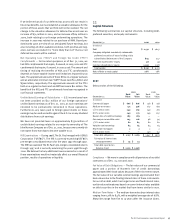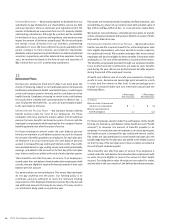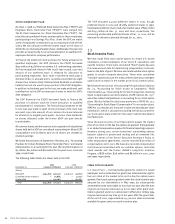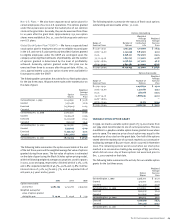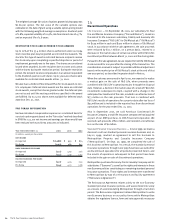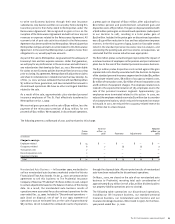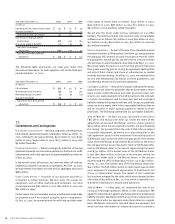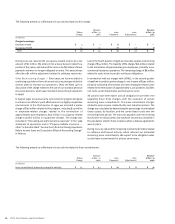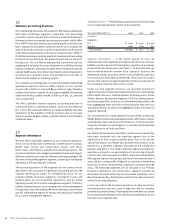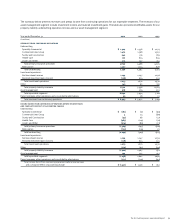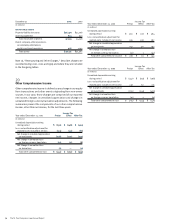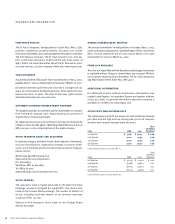Travelers 2001 Annual Report Download - page 69
Download and view the complete annual report
Please find page 69 of the 2001 Travelers annual report below. You can navigate through the pages in the report by either clicking on the pages listed below, or by using the keyword search tool below to find specific information within the annual report.
The St. Paul Companies 2001 Annual Report 67
range of additional liability. We purchased insurance to cover a
portion of our exposure to such claims.
Under the sale agreement, we also committed to pay Aon
commissions representing a minimum level of annual reinsurance
brokerage business through 2012. We also have commitments under
lease agreements through 2015 for vacated space (included in our
lease commitment totals above), as well as a commitment to make
payments to a former Minet executive.
Acquisitions — We may be required to make an additional payment
of up to $20 million related to our purchase of the right to seek
to renew Fireman’s Fund surety business, based on the volume
of business renewed within one year of purchase. Our asset
management subsidiary, Nuveen, may be required to make
additional payments of up to $180 million related to their acquisition
of Symphony, based on reaching specified performance and
growth targets.
Joint Ventures — Our subsidiary, Fire and Marine, is a party to five
separate joint ventures, in each of which Fire and Marine is a 50%
owner of various real estate holdings and does not exercise control
over the joint ventures, financed by non-recourse mortgage notes.
Because we own only 50% of the holdings, we do not consolidate
these entities and the joint venture debt does not appear on our
balance sheet. Our maximum exposure under each of these joint
ventures, in the event of foreclosure of a property, is represented
by our carrying value in the joint venture, ranging individually from
$7 million to $31 million, and cumulatively totaling $65 million at
Dec. 31, 2001.
Municipal Trusts — We have purchased interests in certain
unconsolidated trusts holding highly rated municipal securities that
were formed for the purpose of executing corporate tax strategies.
Related to our interests, we are contingently liable for a portion of
the interest rate risk of the municipal securities we sold to the trust.
As of Dec. 31, 2001, our contingent liability was less than $1 million.
Legal Matters — In the ordinary course of conducting business, we,
and some of our subsidiaries, have been named as defendants in
various lawsuits. Some of these lawsuits attempt to establish
liability under insurance contracts issued by our underwriting
operations. Plaintiffs in these lawsuits are asking for money
damages or to have the court direct the activities of our operations
in certain ways.
It is possible that the settlement of these lawsuits may be material
to our results of operations and liquidity in the period in which they
occur. However, we believe the total amounts that we, and our
subsidiaries, will ultimately have to pay in these matters will have
no material effect on our overall financial position.
16
Restructuring and Other Charges
Fourth-Quarter 2001 Strategic Review — In December 2001, we
announced the results of a strategic review of all of our operations,
which included a decision to exit a number of businesses and
countries, as discussed in Note 3. Related to this strategic review, we
recorded a pretax charge of $62 million, including $46 million of
employee-related costs, $9 million of occupancy-related costs,
$4 million of equipment charges and $3 million of legal costs. The
charge was included in “Operating and administrative expenses” in
the 2001 statement of operations; with $42 million included in
“Property-liability insurance — other” and $20 million included in
“Parent company, other operations and consolidating eliminations”
in the table titled “Income (Loss) from Continuing Operations Before
Income Taxes and Cumulative Effect of Accounting Change” in Note 19.
The employee-related costs represent severance and related
benefits such as outplacement services to be paid to, or incurred
on behalf of, employees to be terminated by the end of 2002.
We estimated that a total of approximately 1,200 employee
positions would ultimately be terminated under this action, with
approximately 800 expected to be terminated by the end of 2002.
The remaining 400 employees were not included in the restructuring
charge since they will either be terminated after 2002 or are part
of one of the operations that may be sold. Of the total,
approximately 650 work in offices outside the U.S. (many of which
are closing), approximately 300 are in our Health Care business
(which is being exited), and the remaining 250 are spread
throughout our domestic operations.
The occupancy-related cost represents excess space created by the
terminations, calculated by determining the anticipated excess
space, by location, as a result of the terminations. The percentage
of excess space in relation to the total leased space was then
applied to the current lease costs over the remaining lease period.
The amounts payable under the existing leases were not discounted,
and sublease income was included in the calculation only for those
locations where sublease agreements were in place. The equipment
costs represent the net book value of computer and other equipment
that will no longer be used following the termination of employees
and closing of offices. The legal costs represent our estimate of fees
to be paid to outside legal counsel to obtain regulatory approval to
exit certain states or countries.
No payments were made in 2001 related to this action.
MMI Acquisition — Related to our April 2000 purchase of MMI (see
Note 4), we recorded a charge of $28 million, including $4 million
of employee-related costs and $24 million of occupancy-related
costs. The employee-related costs represented severance and
related benefits such as outplacement counseling to be paid to, or
incurred on behalf of, terminated employees. We estimated that
approximately 130 employee positions would be eliminated, at all
levels throughout MMI, and 119 employees were terminated. The
occupancy-related cost represented excess space created by the
terminations, calculated by determining the percentage of
anticipated excess space, by location, and the current lease costs
over the remaining lease period. The amounts payable under the
existing leases were not discounted, and sublease income was
included in the calculation only for those locations where sublease
agreements were in place.
The charge was included in “Operating and administrative
expenses” in the 2000 statement of operations and in “Property-
liability insurance — other” in the table titled “Income (Loss) from
Continuing Operations Before Income Taxes and Cumulative Effect
of Accounting Change” in Note 19.


